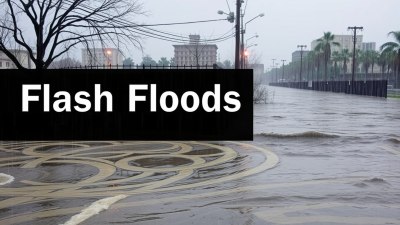How Lightning Alerts Can Become Your New Reminder System
Discover how lightning alerts can be transformed into an innovative reminder system to boost your productivity and safety.

Image by krakenimagescom on Freepik
Lightning alerts are typically used to warn people of impending thunderstorm activity, helping individuals prepare and stay safe. However, these alerts can do far more than just signal imminent weather changes; they have the potential to be repurposed into a highly effective reminder system that enhances productivity and organization in daily life.
In this article, we will explore the concept of lightning alerts, how they work, the types of technologies used to detect them, and how this information can be applied in innovative ways to support personal and professional reminders. We will also discuss practical examples, effective implementation strategies, and the benefits of adopting lightning-based notifications as part of your reminder ecosystem.
Understanding Lightning Alerts and Their Technology
Lightning alerts originate from systems designed to detect electrical discharges in the atmosphere. These detections rely on various technologies, including ground-based sensors, satellite imagery, and radio frequency analysis. Networks of sensors pick up electromagnetic signals produced by lightning strikes and relay this information to weather services, which in turn send alerts to users.
The alerts typically specify the location and time of detected lightning strikes, providing real-time data for individuals and organizations to take necessary safety precautions. Examples include alerting outdoor workers to seek shelter or warning event organizers to postpone activities during thunderstorms.
With the advancement of digital communication methods, such as mobile push notifications and smart home integrations, lightning alerts can be harnessed beyond weather updates by triggering customized warning or reminder categories.
Why Use Lightning Alerts as Reminders?
Integrating lightning alerts into reminder systems brings several advantages. First, these alerts are moment-sensitive, meaning they respond immediately to environmental triggers. This immediacy can help people maintain awareness of specific tasks that need to be addressed as conditions change.
Second, lightning strikes are natural and irregular phenomena; their unpredictability means reminders based on lightning can serve as novel cues breaking the monotony of traditional scheduling methods. This unpredictability can spark increased attentiveness in users.
Third, lightning alerts are often location-specific. Thus, reminders can be tailored to when and where they are most relevant, increasing contextual awareness and reducing unnecessary notifications.
Practical Applications of Lightning-Based Reminders
Several domains can benefit from adapting lightning alerts into reminder systems. For instance, outdoor workers can receive notifications to check equipment or safety protocols when lightning is detected nearby.
Sports coaches and players might use alerts to pause or continue training sessions depending on weather safety. Event planners could receive reminders to prepare contingency plans or communicate with attendees in real time.
On a personal level, lightning alerts could be integrated with smart home devices to prompt reminders associated with power usage or battery backup, as lightning often precedes electrical outages.
How to Implement Lightning Alert Reminders
The transformation of lightning alerts into personalized reminders requires combining weather data APIs, notification platforms, and customizable software interfaces. Developers can access lightning strike data from open weather services or specialized providers that deliver lightning-specific feeds.
Once the data is accessible, users can set rules defining the conditions under which they want to receive reminders. For example, if lightning strikes within a certain radius of their location, a notification triggers a predetermined reminder message or action.
This system relies heavily on geolocation services and configurable parameters for proximity and timing. Integrations with smartphone apps, calendar applications, or IoT devices enhance flexibility and usability.
Device Compatibility and User Experience
To maximize the effectiveness of lightning alert reminders, the system should be compatible with a variety of devices, including smartphones, tablets, smartwatches, and home automation hubs. Mobile devices with GPS capabilities provide highly accurate location data, enabling precise alert targeting.
Users benefit from customizable notification settings such as sound, vibration, or visual cues, depending on personal preference and context. Advanced systems might incorporate machine learning to optimize alert frequency and minimize false alarms, ensuring reminders remain meaningful and are not dismissed as noise.
Case Study: Outdoor Event Management
Consider an outdoor music festival organizer who integrates lightning alert reminders into their event management software. When lightning is detected within a specified radius, the system sends immediate alerts to staff to initiate shelter protocols, pause performances, or evacuate crowds if necessary.
Additionally, these lightning alerts could trigger reminders to communicate with attendees via social media or push notifications concerning updated safety measures. This real-time responsiveness enhances both safety and operational efficiency.
By combining weather data with task management, the event team can better coordinate resources and reduce risks associated with unexpected storms.
Potential Challenges and Solutions
While the concept is promising, there are challenges to consider. False positives or inaccuracies in lightning detection could lead to unnecessary reminders, causing annoyance or alert fatigue. Providers should select data sources known for high precision and low latency.
Another issue is connectivity; in remote areas, mobile or internet services may be unreliable, impeding alert delivery. Hybrid systems that include radio or satellite communication, or offline caching of recent alerts, can mitigate this problem.
Privacy concerns also arise when continuous location tracking is involved. Transparent data policies and user controls over data sharing are essential to foster trust and compliance with privacy regulations.
Future Trends in Lightning Alert Reminders
Emerging technologies promise to enhance lightning-based reminder systems. Integration with AI-driven personal assistants could allow for more context-aware notifications, balancing urgency with user activity and preferences.
Improvements in sensor networks will yield more granular and timely lightning data, enabling hyper-localized reminders. The development of 5G and edge computing will reduce latency, making notifications faster and more reliable.
Furthermore, combining lightning alert systems with other environmental sensors—such as temperature, humidity, and wind speed detectors—can enrich the reminder ecosystem, providing multidimensional insights and smarter task scheduling based on integrated environmental conditions.
How to Get Started Today
For individuals interested in experimenting with lightning alerts as reminders, several steps can kickstart the process. First, explore weather applications that provide lightning detection features and support customizable alerts.
Next, investigate third-party APIs that expose lightning data and determine how you can connect them with personal productivity tools such as task managers or calendar apps using automation platforms like IFTTT or Zapier.
Developers can build proof-of-concept applications or scripts that respond to lightning notifications by creating reminders. Starting with simple triggers before advancing to complex rule sets facilitates learning and iteration.
Lightning alerts represent a unique and underutilized resource that can be creatively repurposed as dynamic reminder triggers. Their immediacy, location specificity, and environmental context provide a natural framework for signaling important tasks and safety measures tied to external conditions.
By leveraging modern connectivity, data services, and user-friendly interfaces, lightning alert reminders have the potential to transform how individuals and organizations stay organized, safe, and responsive to the world around them. The integration of weather awareness with personal and professional task management signals a forward-thinking approach toward enhanced situational intelligence and productivity.











